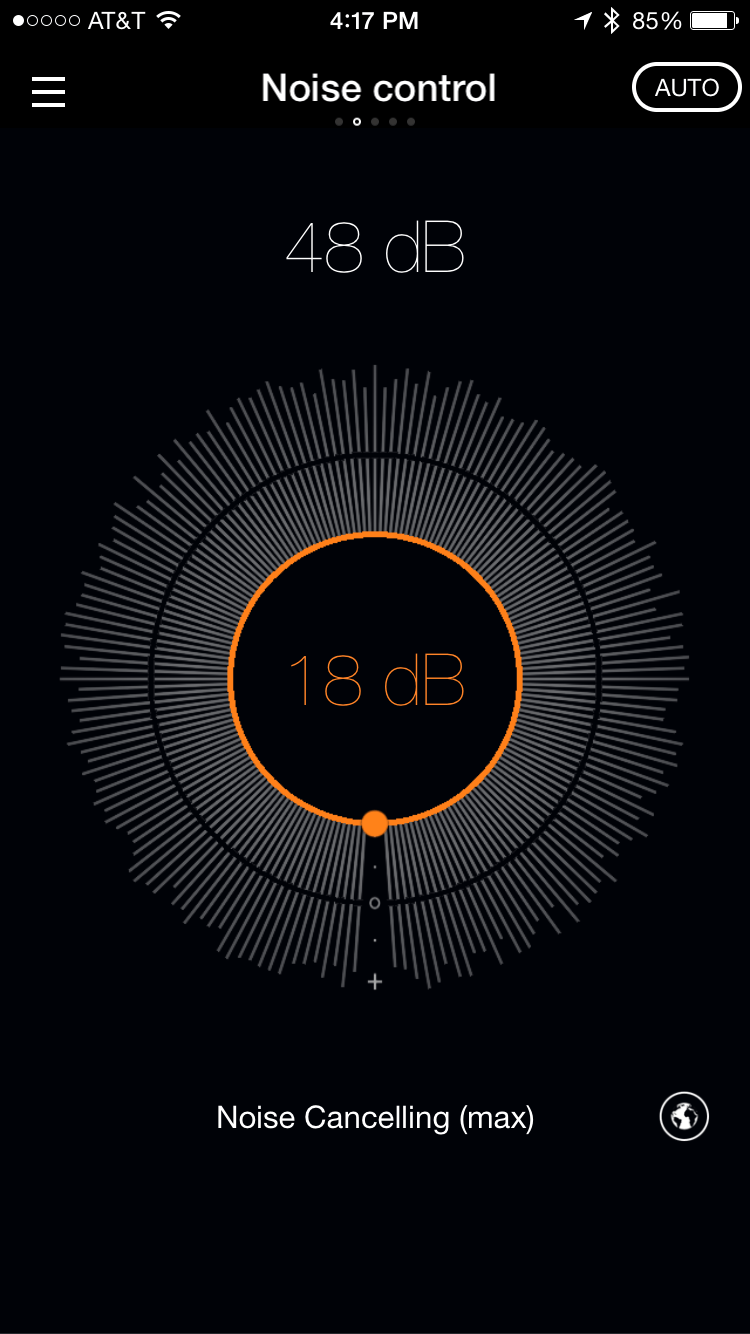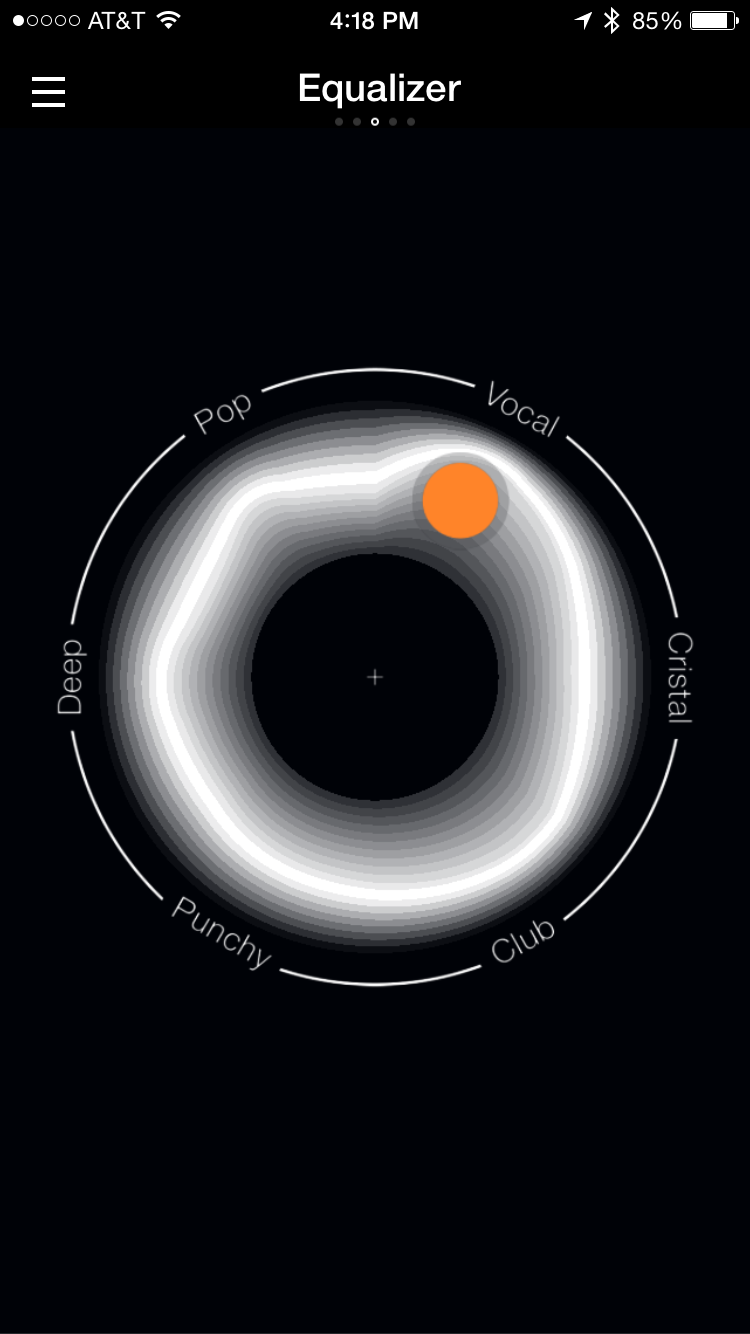- Comfortable and stylish design
- Top-notch noise canceling
- Features, features, and more features
- Clear and detailed sound, even wirelessly
- Highly processed sound signature
- Mediocre battery life
It’s been nearly three years since French-based drone maker Parrot brought its gaze down from the skies to try its hand at high-end wireless headphones. The original Parrot Zik’s stylish, minimalist exterior hid a treasure trove of tech under the hood, blurring the line between traditional headphones and state-of-the-art wearables.
Now three generations on, the company’s constant quest for innovation has resulted in a more streamlined design and a supercharged app to create the most advanced pair of wireless headphones in the world, the Parrot Zik 3 ($400). The latest in the Zik family offers a sprawling list of features, from dead quiet active noise cancelling to Qi wireless charging, and even Apple Watch support. And, oh yeah, they play music, too. But does all that state-of-the-art tech make the Zik 3 a must-buy in this new wireless world?
The cans
The Zik’s striking design has been key to its popularity, offering a modern aesthetic with just a tinge of classic chic, along with plenty of padding for comfort. The third iteration continues that tradition, though, unlike the complete makeover that was the Zik 2.0, the 3’s aesthetic is a modest upgrade with basic refinements. The cans keep the signature curves of glossy metal along the arms and band and the same slimmed-down earpieces, but the supple leather along the exterior is now available in textured diamond or alligator stitching, and in a rainbow of colors.
You can’t see most of the Zik 3’s tech at a glance, but myriad innovations linger just beneath the surface, many of which are slyly embedded into the right earpiece. Sunken into the ample padding are a pair of “Presence Sensors,” which allow the cans to automatically pause music and disengage noise cancellation when you take them off, thus saving battery life. Like a lot of new wireless cans, the outer side of the earpiece is a touch sensor as well (like the 2.0), allowing for control of play/pause/calling, song skip, and independent volume adjustment with a quick tap or slide of your finger. The system is very sensitive, but it works pretty well once you get the hang of it.
Also on board is an advanced six-piece microphone system, utilized not only to muffle the world around you, but also to amplify it when using the “Street Mode” feature to help you keep aware of your surroundings.
The striking design offers a modern aesthetic with just a tinge of classic chic.
A magnetic cover on the left earpiece pops off to reveal a removable battery, which (annoyingly) must be inserted and charged up when the cans arrive. Battery life has improved over last year, though at just seven hours of runtime it’s still a weakness. However, the design does make it easy to swap in a backup battery if you decide to pick one up. The real prize, though, is the sensor that allows for wireless charging located just below. It should be noted here that to charge wirelessly, you’ll need to get your own Qi wireless charger, as the cans arrive with only a micro-USB power adapter, a 3.5mm cable, and a soft carrying pouch.
Though the Zik 3 are aimed at wireless listening first, there are not one but two ways to plug-and-play: The standard 3.5mm input allows for analog playback without the battery, while the micro-USB port pulls double duty as a charging port and a digital input for hi-res audio at up to 24bit/192kHz. We had some hiccups with digital connection and playback a few times with our Macbook Air, but it seemed to smooth out over the course of our review.
Finally, the power key at the base of the right earpiece represents the only tactile button on board, automatically engaging pairing, noise cancellation, and even DSP by default when you power the Zik on.
It all amounts to more options than most listeners will know what to do with — and to paraphrase Al Pacino from Scent of a Woman, we’re just getting warmed up! Like most modern tech, the Zik 3’s real horsepower is built into a dedicated app.
The app
You don’t need an audio engineering degree to properly configure the Zik’s iOS or Android apps, but it wouldn’t hurt. The system harbors a labyrinth of functionality, offering everything from adaptable noise cancellation and DSP, to a fully-programmable audio preset/EQ system that can even be set to activate when playing a specific album or song.
You don’t need an audio degree to use the Zik 3’s app, but it wouldn’t hurt.
Users of previous Zik models will recognize the basic layout, which begins on the Home page with a circular dial at the top indicating battery life, and buttons below to engage/disengage Noise Control, Equalizer, and Concert Hall (i.e. DSP). For some reason, Parrot sets Concert Hall on by default which means, as we mentioned in our Zik 2.0 video, you have to fire up the app to turn it off — or plug in analog-style with the cans powered down.
Swiping left digs deeper into the app, with a dedicated page for each of the three primary presets, beginning with Noise Control. Before you start listening, the app will ask to use your GPS location info to help with noise cancellation, supposedly adjusting the noise level for your global position. The system indicates the info with a color code on the “Noise Map” (found in the Settings menu). More practically, the orange dial in the center allows you to set noise cancelling to basic, off, or max, and you can do the same with Street Mode to control environmental ambience.
The Equalizer page is uniquely configured, though it’s simple enough once you dig in. Presets like Deep and Vocal allow you to brighten or darken the sound to your taste by dragging the little orange dot from the center towards them. You can also go deeper in “Producer Mode” by clicking the icon at the lower right, calling up a full parametric EQ (not for the casual user) as well as DSP features, which can then be saved and even uploaded to the web.
DSP is the next page in the order, and it allows you to make your virtual listening environment larger or smaller — from “Silent Room” to “Concert Hall.” You can also expand or contract the stereo image by dragging on the orange halo at the center, indicated by dual speaker icons for the left and right channels. We generally preferred keeping the DSP off, but, unless you plug in the old fashioned way, there’s no escaping the Zik’s affected sound signature no matter which features you employ. But we’ll get to that in a moment.
Finally, there are more features in the Settings section, similar to the layout of your smartphone. Multiple windows allow you to fine tune the cans, like setting automatic power-down time frames (at 5 mins, 10 mins resting, etc.), Noise Control settings for phone calls, Presence Sensor on/off, and even text-to-speech in a variety of languages for when you can’t get to your phone.
As for the Zik 3’s Apple Watch app, functionality is pared down significantly. Fans of the Cupertino wearable will get basic features on their wrist, however, including the ability to control Concert Hall DSP and noise cancellation settings, as well as to monitor battery level and optimize it.
Noise cancellation and comfort
Simply put, the Zik 3 offer the best noise cancelling we’ve heard outside of the Bose QC25. And even when matched against Bose’s industry standard, it’s pretty close.
As for comfort, apart from a bit of wear at the top of the band over time, the Zik offer a smooth and snug ride, making them utterly enticing for the weary traveler.
The sound
If you search the web for descriptions of the Parrot Zik’s sound, you’ll find a lot of brief synopses with enough ambiguity to start a ‘70s glam-rock band. The headphones have “good detail for a Bluetooth headphone,” “good sound for the price,” etc.; Not exactly awash in ornate description. We think that’s due, in part, to a sound signature that’s hard to distill into words. The best way we can describe them is to say they sound a bit like wearing cybernetic ears.
While the music is reproduced with supreme clarity — especially when sourcing hardwired audio from the digital input — there’s an unmistakable synthetic quality that runs through the heart of every track, most evident in the timbres of natural instruments like strings and guitar, brass, and woodwinds. If you’re anything like us, you’ll find yourself constantly fiddling with the DSP settings to find a better overall reproduction. That digital shimmer definitely softens up when you power down and plug in the old fashioned way. But make no mistake, even with all of the effects disengaged, there’s no running away from Parrot’s heavy signal processing when the cans are turned on; Like Prego, “it’s in there.”
That’s not to say the Zik 3 don’t offer competitive, even impressive sound for a wireless headphone in their class. Instruments are well balanced, with a clean and clear midrange, and firm, punchy bass. Even when things get fuzzier via Bluetooth connection, the Zik really hold their own at their price point when it comes to delineating the finer details of music.

Going head-to-head with Sennheiser’s flagship wireless cans, the Momentum 2.0, the decision comes down more to preference than objective superiority. The Momentum carve out the subtler elements with a bit more precision, evident in tracks like Radiohead’s Reckoner in which the silvery textures of the tambourine are polished with a bit more shimmer. But the real difference is in the color of the music — the Momentum offer a darker shade, but more to the point, they bring out the organic flavors of instruments more naturally. In Ray LaMontagne’s acoustic track Winter Birds, for instance, the Sennheiser reproduce the guitar in rich, warm waves of gold. In contrast, the Zik 3 seem to shave off some of the presence there, and don’t fully draw the breathy tones of Ray’s tortured vocal as convincingly as we’d like.
Still, as in previous models of the Zik, a lot of listeners will be plenty satisfied with the sound provided, which holds up well against the rival Bose QC25, and comes part and parcel with Parrot’s veritable boatload of digital features.
Conclusion
Parrot’s new Zik 3 offer an embarrassing wealth of high-tech features, a sleek and comfy design, and world-class noise cancellation that makes them a top option in the high-end wireless headphone segment. While the highly-affected sound signature isn’t our cup of tea, users looking for an innovative wearable that checks all the right boxes — including the ability to make fellow techies green with envy — will no doubt flock to the latest from Parrot.













![[EMBARGOED IMAGE – 08/02] The Victrola Stream Sapphire wireless turntable.](https://www.digitaltrends.com/wp-content/uploads/2024/08/victrola-stream-sapphire-wireless-turntable-01.jpg?resize=650%2C390&p=1)